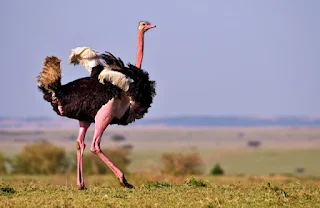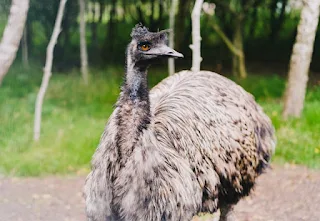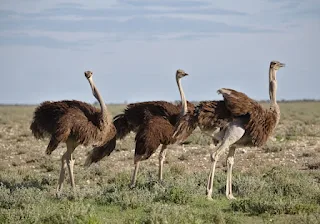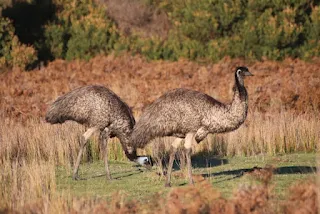Ostrich vs Emu Mystery: How to Tell These Majestic Birds Apart
In the vast landscape of the animal kingdom, birds often captivate us with their beauty, grace, and unique characteristics.
Among these avian wonders, the ostrich and the emu stand out as remarkable creatures, each possessing distinctive features. Despite their similarities, these flightless birds hail from different corners of the globe and boast unique traits that set them apart.
Join us on a journey to unravel the mystery of the ostrich versus emu debate and discover what makes each of these majestic birds genuinely remarkable.
The Basics: Meet the Ostrich and the Emu
Before discussing the finer details, let's introduce our contenders: the ostrich and the emu.
The Ostrich (Struthio camelus)
Standing tall as Earth's most giant living bird, the ostrich is an iconic symbol of the African savannas.
With its long neck, powerful legs, and unmistakable plumage, the ostrich cuts an impressive figure in its native habitat.
Renowned for its remarkable speed and agility, this majestic bird can reach speeds of up to 70 kilometers per hour, making it a true marvel of the natural world.
The Emu (Dromaius novaehollandiae)
Hailing from the vast expanses of Australia, the emu is the second-largest bird in the world, surpassed only by its African counterpart, the ostrich.
Despite its slightly smaller stature, the emu possesses its unique charm and charisma. With its distinctive plumage, curious demeanor, and remarkable adaptability, the emu has earned its place as an emblematic symbol of the Australian outback.
Spotting the Differences: Anatomy and Appearance
At first glance, distinguishing between an ostrich and an emu may seem daunting, given their similar appearance and shared status as large flightless birds.
However, upon closer inspection, several key differences emerge, allowing keen observers to distinguish between these two avian giants.
Size Matters
One of the most noticeable differences between ostriches and emus is their size. While both birds belong to the same family (Ratites), ostriches typically outweigh emus by a significant margin.
On average, adult ostriches can reach heights of up to 2.7 meters and weigh between 100 and 160 kilograms, making them the undisputed heavyweights of the avian world.
In contrast, emus tend to be slightly smaller, with heights averaging around 1.9 meters and weights ranging from 30 to 45 kilograms.
Plumage and Coloration
Another distinguishing feature between ostriches and emus lies in their plumage and coloration.
Ostriches are characterized by their distinctive black and white feathers, which cover much of their bodies and serve as a form of camouflage in their native grassland habitats.
In contrast, emus sport a more subdued color palette, with predominantly brown feathers that help them blend in seamlessly with the arid landscapes of the Australian outback.
Head Shape and Neck Length
Regarding their heads and necks, ostriches and emus also exhibit notable differences.
Ostriches are known for their elongated necks and small, flat heads, which feature large eyes and a prominent beak.
In contrast, emus possess shorter, thicker necks and slightly larger heads, giving them a more robust appearance than their African counterparts.
Habitat and Range: From Savannahs to Outback
While ostriches and emus may share certain physical traits, their habitats and geographic ranges differ significantly, reflecting their evolutionary histories and ecological preferences.
Ostriches: Masters of the Savannah
Ostriches are primarily found in Africa's open grasslands and savannas, where they roam vast expanses in search of food and water.
These highly adaptable birds can thrive in various habitats, from arid deserts to lush meadows, thanks to their ability to regulate body temperature and withstand extreme environmental conditions.
Emus: Navigators of the Outback
In contrast, emus are native to Australia's diverse ecosystems, where they inhabit forests, scrublands, and semi-arid plains.
Renowned for their resilience and resourcefulness, emus have adapted to thrive in some of the Australian continent's harshest and most remote regions, making them integral components of the country's natural heritage.
Behavior and Lifestyle: Insights into Avian Behavior
Beyond their physical attributes and habitats, ostriches and emus also exhibit distinct behaviors and lifestyles that offer fascinating insights into their respective ways of life.
Social Structure
Ostriches are known for their complex social structures, which typically revolve around small family groups led by a dominant male and female.
These groups, known as flocks, engage in cooperative behaviors such as nesting, foraging, and predator defense, with each member playing a vital role in ensuring the group's survival.
In contrast, emus are more solitary by nature, preferring to roam and forage alone or in small groups known as mobs.
While they may come together during the breeding season, emus generally lead independent lives, relying on their keen senses and agility to evade predators and navigate their surroundings.
Reproduction and Parental Care
Both ostriches and emus are renowned for their unique reproduction and parental care approaches.
Female ostriches typically lay their eggs in communal nests, which are incubated and guarded by the dominant female and one or more subordinate females within the flock.
Male ostriches play a crucial role in defending the nest and offspring from potential threats, using their size and strength to deter predators.
Emus, on the other hand, follows a more solitary breeding strategy. Females lay their eggs in simple ground nests before moving on to find additional mates.
Once the eggs hatch, male emus assume sole responsibility for caring for the young, diligently guarding them and teaching them essential survival skills until they are ready to fend for themselves.
Conclusion: Celebrating Diversity in the Avian World
In conclusion, while ostriches and emus may share certain physical traits and evolutionary origins, they are distinct species with unique characteristics and adaptations that reflect their respective habitats and lifestyles.
From the vast savannas of Africa to the rugged landscapes of Australia, these majestic birds continue to captivate our imaginations and inspire awe and wonder in people around the world.
As stewards of our planet's biodiversity, we are responsible for appreciating and celebrating the rich diversity of life that surrounds us, including the remarkable birds that grace our skies and landscapes.
By learning more about creatures like the ostrich and the emu, we can gain a deeper appreciation for the wonders of the natural world and the intricate web of life that sustains us all. So, let us continue to marvel at the beauty and complexity of these magnificent birds and strive to protect and preserve their habitats for generations to come.




Comments
Post a Comment